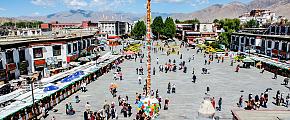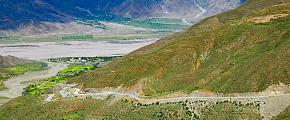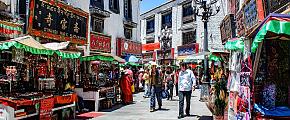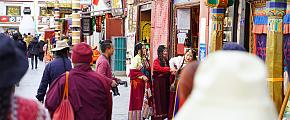Tibet Travel FAQs and Tips
1. How bad is Altitude Sickness in Tibet, and what can I do to avoid, or treat it?
Known as the Roof of the World, Tibet is one of the highest places on earth. Due to Tibet's high altitudes, many visitors from low-altitude areas suffer from altitude sickness. Most people only suffer minor effects of altitude sickness, which include headaches, loss of appetite, and a tendency to have no energy until their bodies adjust to the high terrain. This adjustment can take anywhere from a few hours to, in rare cases, a few days. If visitors do some simple preparations before going to Tibet, most of the symptoms of altitude sickness can be avoided. Being healthy and in good shape, before you arrive in Tibet will help greatly. It is also recommended that you talk to your local physician about AMS pills to help combat altitude sickness. Once arriving in Tibet, walk slowly and take deep breaths. Your tour guide will be there to offer help and suggestions.
2. What is the weather like in Tibet and when is the best time to travel there?
Generally, the weather in Tibet takes some getting used to. Summers are cool, and winters are dangerously cold. Sun radiation is extremely strong in Tibet. Most annual rainfall falls from June to September. In the Lhasa and Shigatse areas, rains usually come in the evening. The best time to visit Tibet is from April to October. The best time to visit Mt. Everest is in May and early October. The peak tourism season runs from July 1st to October 15th.
3. What should I take along with me while traveling to Tibet?
There are many items that visitors are recommended to take with them when they travel to Tibet. A personal medical kit, water bottle, sunglasses, sunblock, and a scarf or mask for keeping blocking dust. If you are a photography lover, do not forget your camera, film, and batteries, or you will never forgive yourself.
4. What kind of vehicles is available for getting around Tibet?
In Lhasa, there are many options for getting around, such as taxis, buses, minibusses, pedicabs, and jeeps. There are also cars and bikes for rent. In more remote areas, the road conditions are not very well developed, making traveling by taxi and bus impossible. In this case, minibusses and jeeps are the only options.
5. What are accommodations like?
There are many hotels in the major cities or towns of Tibet, though four and five-star hotels are quite limited. These hotels have central heating which is used in winter but no cooling is available in summer. The facilities and service standards may not be as you would expect from a hotel with this grade in other parts of the world. In the smaller towns in Tibet, star-graded hotels are not available, and in many places only budget guesthouses are available.
6. What cuisine options are there in Tibet? Are there other options besides only local foods?
Due to the harsh living environment of Tibet, the traditional Tibetan food is quite different from the cuisine found in other parts of the world, and many visitors do not like it when they try it for the first time. Due to its uniqueness, it is highly recommended that visitors at least sample the local foods. There are many kinds of foods available in Tibet's cities. Chinese food, western food, and Nepali food can be found. In remote towns and areas, choices are limited. Chinese food or Sichuan cuisine is probably the best choice.
7. What are the currency and the ATM system in Tibet like?
Foreign currencies cannot be used directly in Tibet, but you can exchange your money at the Bank of China in Shigatse and Lhasa, and these two cities could accept all major credit cards. Your hotels also can change money for you and ATMs are easy to find. However, in remote places in Tibet, banking services and ATM systems are not so easy to find.
8. Will there be problems with the language barrier?
Visitors to Tibet do not need to worry about the language barrier at all. Each visitor will have an English-speaking tour guide, and most of the desk staff in the larger hotels can speak some English. The three main languages used in Tibet are Chinese, Tibetan and English. If you are an individual traveler, you will find many people who can speak these three k languages in Tibet's most popular tourist places.
Contact us if you want to explore more of Tibet or other cities in China.
Related Posts You May Like
What Our Clients Say
SUBSCRIBE TO WIN A FREE TOUR
Subscribe to our newsletter for a chance to win a free 7-day Peru tour! And more insider travel news, exclusive offers, and inspiration will be sent straight to your inbox.







